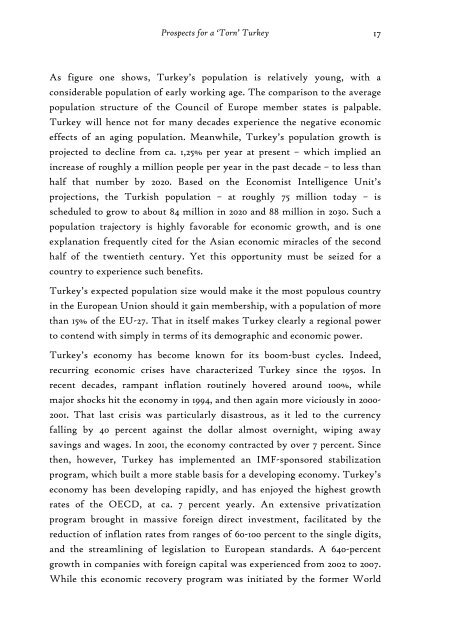2008_10_SRP_CornellKaraveli_Turkey
2008_10_SRP_CornellKaraveli_Turkey
2008_10_SRP_CornellKaraveli_Turkey
You also want an ePaper? Increase the reach of your titles
YUMPU automatically turns print PDFs into web optimized ePapers that Google loves.
Prospects for a ‘Torn’ <strong>Turkey</strong> 17<br />
As figure one shows, <strong>Turkey</strong>’s population is relatively young, with a<br />
considerable population of early working age. The comparison to the average<br />
population structure of the Council of Europe member states is palpable.<br />
<strong>Turkey</strong> will hence not for many decades experience the negative economic<br />
effects of an aging population. Meanwhile, <strong>Turkey</strong>’s population growth is<br />
projected to decline from ca. 1,25% per year at present – which implied an<br />
increase of roughly a million people per year in the past decade – to less than<br />
half that number by 2020. Based on the Economist Intelligence Unit’s<br />
projections, the Turkish population – at roughly 75 million today – is<br />
scheduled to grow to about 84 million in 2020 and 88 million in 2030. Such a<br />
population trajectory is highly favorable for economic growth, and is one<br />
explanation frequently cited for the Asian economic miracles of the second<br />
half of the twentieth century. Yet this opportunity must be seized for a<br />
country to experience such benefits.<br />
<strong>Turkey</strong>’s expected population size would make it the most populous country<br />
in the European Union should it gain membership, with a population of more<br />
than 15% of the EU-27. That in itself makes <strong>Turkey</strong> clearly a regional power<br />
to contend with simply in terms of its demographic and economic power.<br />
<strong>Turkey</strong>’s economy has become known for its boom-bust cycles. Indeed,<br />
recurring economic crises have characterized <strong>Turkey</strong> since the 1950s. In<br />
recent decades, rampant inflation routinely hovered around <strong>10</strong>0%, while<br />
major shocks hit the economy in 1994, and then again more viciously in 2000-<br />
2001. That last crisis was particularly disastrous, as it led to the currency<br />
falling by 40 percent against the dollar almost overnight, wiping away<br />
savings and wages. In 2001, the economy contracted by over 7 percent. Since<br />
then, however, <strong>Turkey</strong> has implemented an IMF-sponsored stabilization<br />
program, which built a more stable basis for a developing economy. <strong>Turkey</strong>’s<br />
economy has been developing rapidly, and has enjoyed the highest growth<br />
rates of the OECD, at ca. 7 percent yearly. An extensive privatization<br />
program brought in massive foreign direct investment, facilitated by the<br />
reduction of inflation rates from ranges of 60-<strong>10</strong>0 percent to the single digits,<br />
and the streamlining of legislation to European standards. A 640-percent<br />
growth in companies with foreign capital was experienced from 2002 to 2007.<br />
While this economic recovery program was initiated by the former World


